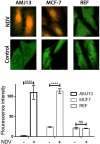Newcastle disease virus suppress glycolysis pathway and induce breast cancer cells death
- PMID: 32904847
- PMCID: PMC7458979
- DOI: 10.1007/s13337-020-00612-z
Newcastle disease virus suppress glycolysis pathway and induce breast cancer cells death
Abstract
Newcastle disease virus (NDV) can modulate cancer cell signaling pathway and induce apoptosis in cancer cells. Cancer cells increase their glycolysis rates to meet the energy demands for their survival and generate ATP as the primary energy source for cell growth and proliferation. Interfering the glycolysis pathway may be a valuable antitumor strategy. This study aimed to assess the effect of NDV on the glycolysis pathway in infected breast cancer cells. Oncolytic NDV attenuated AMHA1 strain was used in this study. AMJ13 and MCF7 breast cancer cell lines and a normal embryonic REF cell line were infected with NDV with different multiplicity of infections (moi) to determine the IC50 of NDV through MTT assay. Crystal violet staining was done to study the morphological changes. NDV apoptosis induction was assessed using AO/PI assay. NDV interference with the glycolysis pathway was examined through measuring hexokinase (HK) activity, pyruvate, and ATP concentrations, and pH levels in NDV infected and non-infected breast cancer cells and in normal embryonic cells. The results showed that NDV replicates efficiently in cancer cells and spare normal cells and induce morphological changes and apoptosis in breast cancer cells but not in normal cells. NDV infected cancer cells showed decreased in the HK activity, pyruvate and ATP concentrations, and acidity, which reflect a significant decrease in the glycolysis activity of the NDV infected tumor cells. No effects on the normal cells were observed. In conclusion, oncolytic NDV ability to reduce glycolysis pathway activity in cancer cells can be an exciting module to improve antitumor therapeutics.
Keywords: Cancer metabolism; Oncolytics; Pyruvate; Virotherapy; Warburg effect.
© Indian Virological Society 2020.
Conflict of interest statement
Conflict of interestThe authors disclose no potential conflict of interest.
Figures







Similar articles
-
Caspase Dependent and Independent Anti-hematological Malignancy Activity of AMHA1 Attenuated Newcastle Disease Virus.Int J Mol Cell Med. 2019 Summer;8(3):211-223. doi: 10.22088/IJMCM.BUMS.8.3.211. Int J Mol Cell Med. 2019. PMID: 32489950 Free PMC article.
-
Antimetastatic and antitumor activities of oncolytic NDV AMHA1 in a 3D culture model of breast cancer.Front Mol Biosci. 2024 Aug 30;11:1331369. doi: 10.3389/fmolb.2024.1331369. eCollection 2024. Front Mol Biosci. 2024. PMID: 39281317 Free PMC article.
-
Hexokinase inhibition using D-Mannoheptulose enhances oncolytic newcastle disease virus-mediated killing of breast cancer cells.Cancer Cell Int. 2020 Aug 28;20:420. doi: 10.1186/s12935-020-01514-2. eCollection 2020. Cancer Cell Int. 2020. PMID: 32874134 Free PMC article.
-
Newcastle disease virus strain AF2240 as an oncolytic virus: A review.Acta Trop. 2018 Jul;183:126-133. doi: 10.1016/j.actatropica.2018.04.007. Epub 2018 Apr 4. Acta Trop. 2018. PMID: 29626432 Review.
-
Therapeutic potential of oncolytic Newcastle disease virus: a critical review.Oncolytic Virother. 2015 Mar 27;4:49-62. doi: 10.2147/OV.S78600. eCollection 2015. Oncolytic Virother. 2015. PMID: 27512670 Free PMC article. Review.
Cited by
-
Evaluation of the in vitro and in vivo effect of liposomal doxorubicin along with oncolytic Newcastle disease virus on 4T1 cell line: Animal preclinical research.Vet Med Sci. 2023 May;9(3):1426-1437. doi: 10.1002/vms3.1109. Epub 2023 Mar 15. Vet Med Sci. 2023. PMID: 36920334 Free PMC article.
-
Biosynthesis and characterization of platinum nanoparticles using Iraqi Zahidi dates and evaluation of their biological applications.Biotechnol Rep (Amst). 2021 May 18;30:e00635. doi: 10.1016/j.btre.2021.e00635. eCollection 2021 Jun. Biotechnol Rep (Amst). 2021. PMID: 34094893 Free PMC article.
-
Fabrication of zein nanofibrous scaffold containing Scrophularia striata extract for biomedical application.J Biol Eng. 2025 Feb 11;19(1):15. doi: 10.1186/s13036-025-00486-z. J Biol Eng. 2025. PMID: 39934856 Free PMC article.
-
Triggering of the immune response to MCF7 cell line using conjugated antibody with bacterial antigens: In-vitro and in-vivo study.PLoS One. 2022 Oct 7;17(10):e0275776. doi: 10.1371/journal.pone.0275776. eCollection 2022. PLoS One. 2022. PMID: 36206297 Free PMC article.
-
3-Dimensional coculture of breast cancer cell lines with adipose tissue-Derived stem cells reveals the efficiency of oncolytic Newcastle disease virus infection via labeling technology.Front Mol Biosci. 2022 Sep 12;9:754100. doi: 10.3389/fmolb.2022.754100. eCollection 2022. Front Mol Biosci. 2022. PMID: 36172043 Free PMC article.
References
-
- Alfarouk KO, Verduzco D, Rauch C, Muddathir AK, Adil HH, Elhassan GO, et al. Glycolysis, tumor metabolism, cancer growth and dissemination. A new pH-based etiopathogenic perspective and therapeutic approach to an old cancer question. Oncoscience. 2014;1(12):777–802. doi: 10.18632/oncoscience.109. - DOI - PMC - PubMed
-
- AL-Shammari AM, Al-Hilli ZA, Yaseen NY. Molecular microarray study for the anti-angiogenic effect of Newcastle disease virus on Glioblastoma tumor cells. In: Third international scientific conference on nanotechnology, advanced material and their applications. Baghdad: University of Technology; 2011. p. 109–18.
LinkOut - more resources
Full Text Sources
Research Materials
Miscellaneous

